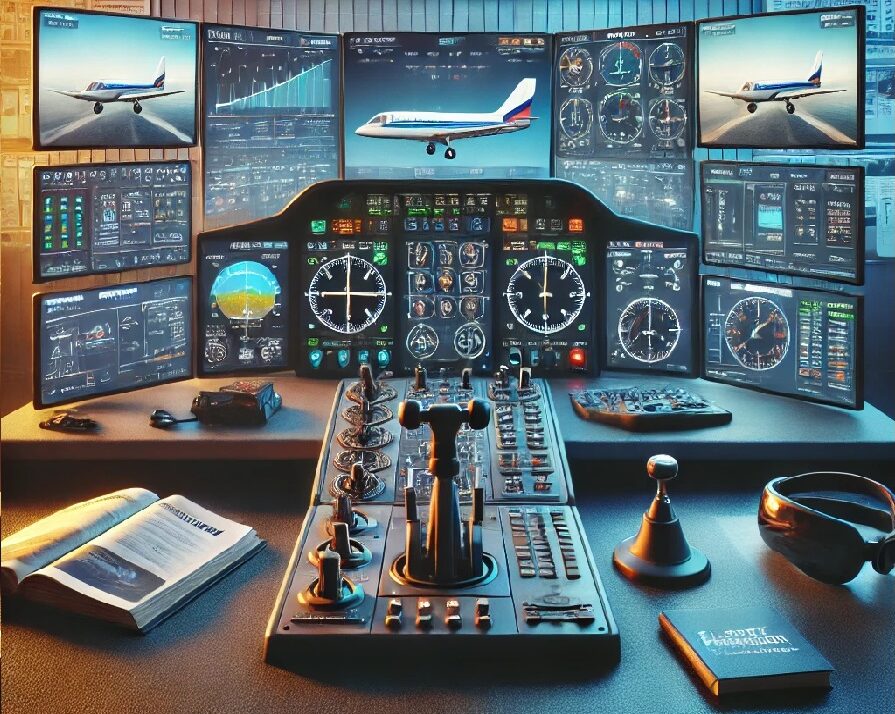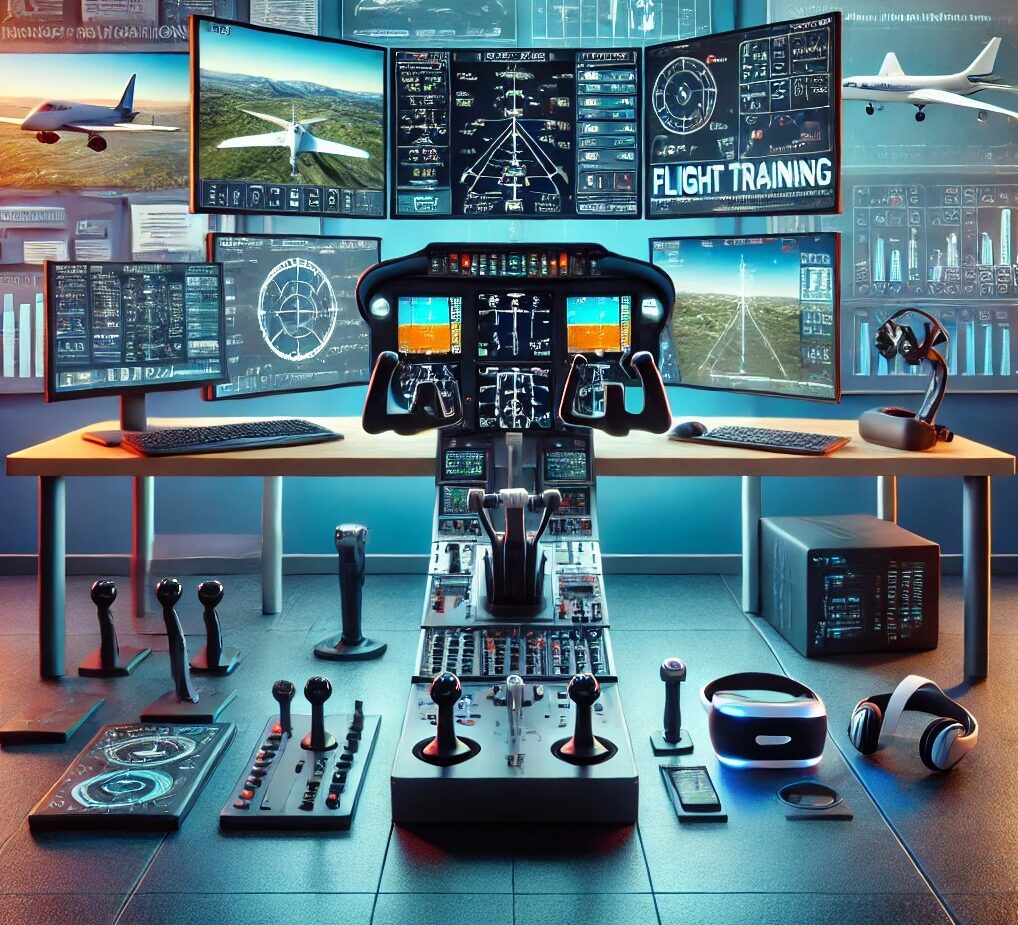Last Updated on March 24, 2025 by MElamin

If you have a passion for aviation and want to experience the thrill of flight from your own home, you’re in the right place. Before you take off from your virtual runway, let me help you understand the necessary qualifications to become a competent flight simulator pilot.
Now, the beauty of flight simulators is that you don’t need a formal qualification to start. However, a keen interest in aviation and a commitment to learning are essential. From understanding the basics of aerodynamics to mastering the cockpit controls, you’re going to find out about all the skills you need to get started. For more info on aerodynamics, check out NASA’s explanation of aerodynamics for beginners.
The heart of the simulator experience lies in the hardware. Start by choosing hardware that fits both your needs and budget. A quality joystick, throttle, and pedals enhance realism and improve your flying skills. High-quality hardware not only increases realism but can improve your flying skills. To learn more about choosing the right setup, explore this Flight Simulator Hardware Guide.
Navigating the vast skies is also about the software. It’s important to select a simulator that suits your level of expertise and interest. Whether it’s the comprehensive Microsoft Flight Simulator, the highly detailed X-Plane, or the mod-friendly FlightGear, I’ll guide you on making the best choice for your aviation adventure.
For more info on these simulators, you can visit their official sites:
This isn’t just about playing a game; it’s also about embarking on a learning journey. As we transition to the next section, ‘Learning to Fly Virtually: Training and Educational Pathways,’ you’ll discover various resources to build your knowledge and refine those pilot skills. Let’s set the stage for a smooth takeoff into the world of flight simulation.
Learning to Fly Virtually: Training and Educational Pathways:

Becoming adept at flight simulation isn’t just about having the gear; it’s about learning to use it effectively. I’m here to help you with resources that can transform you from a novice to a competent virtual pilot.
If you want to get serious about flight simulation, you’ve got to explore both official and community-based training. That’s going to include tutorials from software developers, simulation webinars, and user-created guides that are abundant in online forums. To learn more about training resources, check out the Flight Simulation Association’s resource hub.
Real-world pilots often use simulators for practice, and you can too. It’s an excellent way to grasp the fundamentals of flying without leaving the ground. Flight simulation mimics real-life flying conditions, which is why it’s increasingly incorporated into pilot training curricula.
Now, what if you’re deciding between a self-taught path or a more structured course? While self-teaching demands discipline and motivation, it offers unparalleled flexibility. On the flip side, structured courses provide a roadmap, often with personalized feedback from experienced sim pilots or even real-world aviators.
Choose something that resonates with you, whether it sinks into a deep dive on your own or follows the steady glide path of a formal course. Remember, your first attempt doesn’t need to be your last, and you can always adjust your approach down the road. Next, you’ll need to do some online research to determine what it takes to be a pilot.
Realism in the Virtual Skies: Advanced Qualifications and Certifications:

So you’ve got the basics down, and now you’re hungry for more? I’m going to walk you through upgrading your simulation game with advanced qualifications and certifications that bring realism to a whole new level.
To deepen your flight simulation skills, focus on mastering Instrument Flight Rules (IFR), Visual Flight Rules (VFR), and effective Air Traffic Control (ATC) communication. These trainings are not just about flying; they’re about navigating and communicating as you would in real flight conditions.
You’re going to find out about the value of virtual licenses and ratings. Although they aren’t required by law, they’re a testament to your commitment and skill, and they pave the way for more complex and rewarding simulation experiences.
Participating in simulation networks and events is also a powerful way to gain realistic experience. You’ll have to deal with dynamic weather, unexpected air traffic, and real-time ATCs—much like the real world.
This isn’t just a solitary hobby; it’s a way to connect with others who share your passion. Choose something that resonates with you, whether it’s casual flying or participating in detailed, multi-hour commercial flights.
Overcoming Turbulence: Challenges and Solutions in Flight Simulation:

You’re going to discover that stepping into the world of flight simulation isn’t always smooth sailing. Like mastering any worthwhile skill, you’ll likely run into a few storms along the way. I’m here to help you navigate through some common challenges and offer you effective solutions.
A significant hurdle for many is getting your simulation rig just right. This isn’t just about picking the right hardware; it’s also about configuring your software to work without hiccups. If you run into technical issues, don’t worry too much about it. There are plenty of online forums and troubleshooting guides created by the simulation community that can help get you back on course.
Another common issue is the steep learning curve. Flight simulators are complex, and grasping the controls and functions can be daunting. My advice is to start with beginner-friendly tutorials and gradually progress to complex tasks. Remember, your first attempt doesn’t need to be your last. You can always adjust your approach down the road.
You’re not alone in this journey. The flight simulation community is vast and usually very welcoming. Get involved with online forums, join virtual flying clubs, and reach out to fellow enthusiasts for support and advice. Sharing your experiences and solutions can also give back to the community that supports your growth.
In my opinion, the best way to overcome any challenge is persistence and embracing the learning process. And as you grow more confident and your horizons expand in the virtual sky, you’ll want to keep that momentum going, which leads us seamlessly into the world of continuous improvement—our next stop.
Maintaining Altitude: Staying Current as a Simulator Pilot:

So, you’ve made it through the turbulence and now, you’re cruising steadily as a competent simulator pilot. But as with any skill, staying sharp and updated is crucial. That’s where the concept of continuous improvement comes into play.
Practicing regularly is the most straightforward way to maintain your proficiency. Just like actual pilots must log a certain number of hours to keep their licenses active, dedicating time to your simulator can help you keep your virtual skills on point.
Flight simulation software is an ever-evolving platform. Updates and upgrades can introduce new features, aircraft, and environments that enhance realism and challenge. Staying on top of these changes ensures you don’t fall behind and continue to enjoy an immersive experience.
In my opinion, one of the best ways to stay engaged and informed is by joining a virtual flying club or an online community. Not only do these groups provide a way to share experiences and tips, but they also often organize events and challenges that can test your skills and knowledge.
For more info on connecting with other enthusiasts, visit the AVSIM community.
Finally, I’d encourage you to always stay curious. The world of flight simulation offers endless learning opportunities, so take advantage of them! Don’t be afraid to try new software, explore different aircraft, and push the boundaries of your virtual cockpit.
I really hope you enjoyed this look into what it takes to become and remain a flight simulator pilot. I’m here to help you with any questions you may have, just reach out! Soar high and keep your eyes on the horizon in your virtual adventures. Feel free to leave your comments below.

Thank you for this article – How to become a professional pilot. Being a pilot is a huge role, this is not a profession where there is room for errors. I totally understand why it is difficult to complete the course and get a license. One should be healthy and well trained before completing the course.
Thanks for the comment and visiting my website. It is important to pass medical requirement and exam to become a licensed pilot. It will be easy to pass the exam if you are really interested in aviation.
Howdy MElamin! I really enjoyed going through this review. My brother and I really like and enjoy this product. Having all the disks works great. No internet needed to enjoy flying. Only need the Internet for updates. Anyways I am sure it’s a really good Sim! Although It will really need a Top notch System to play well.
Thanks for the comment.
Well Done Mohammed, thanks for making it simple and easy for us.
Well a very great site, i don’t know much about a pilot, but your site help me understand what it takes to become one. the content is very will placed and easy to read. A couple time in my life i had thought about what it would take to become a pilot, now i know understand how much hard it would take. some of the paragraphs are a little long, might make them into smaller one to make it a little easier to read, but other than that it’s a really really got topic and site
Thanks for the feedback and I will make paragraph shorter. You must meet certain qualification to become a pilot and obtain the pilot licence,